
First and Only Weekly Online Fanzine Devoted to the Life and Works of Edgar Rice Burroughs Since 1996 ~ Over 15,000 Webpages and Webzines in Archive |

First and Only Weekly Online Fanzine Devoted to the Life and Works of Edgar Rice Burroughs Since 1996 ~ Over 15,000 Webpages and Webzines in Archive |

|
Before and After ERB's Vision
|
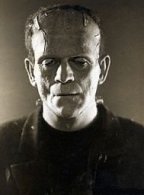
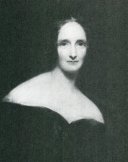
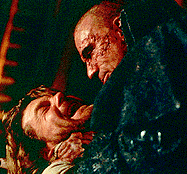
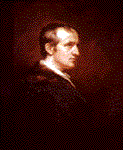 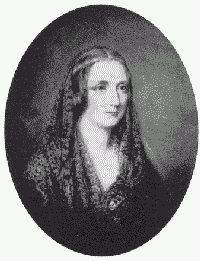 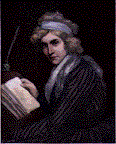 |
| Mary Shelley was the daughter of William Godwin, a political theorist, novelist, and publisher who introduced her to eminent intellectuals and encouraged her youthful efforts as a writer; and of Mary Wollstonecraft, a writer and early feminist thinker, who died shortly after her daughter's birth. |
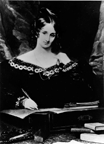 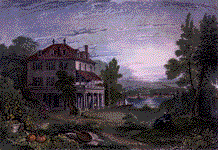 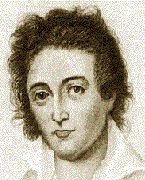 |
| At fifteen, Mary met the poet Percy Shelley, who was married at the time. Two years later, she ran off with him to France. They were married in December 1816, two weeks after Percy Shelley's first wife drowned. By then Mary had already borne him two children. In the summer of 1816, nineteen-year-old Mary Wollstonecraft Godwin and her lover, the poet Percy Shelley visited the poet Lord Byron at his villa beside Lake Geneva in Switzerland. One evening, Byron challenged his guests to each write a ghost story. Mary's story, inspired by a dream, became Frankenstein. |
When I placed my head upon my pillow, I did not sleep, nor could I be said to think. . . . I saw--with shut eyes, but acute mental vision--I saw the pale student of unhallowed arts kneeling beside the thing he had put together. I saw the hideous phantasm of a man stretched out, and then, on the working of some powerful engine, show signs of life, and stir with an uneasy, half-vital motion. Frightful must it be; for supremely frightful would be the effect of any human endeavor to mock the stupendous Creator of the world.Mary Shelley, from her introduction to the third edition of Frankenstein
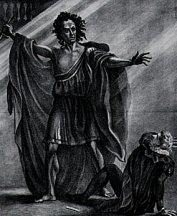 |
Shelley's
original novel, memorable for its story and ambitious in the large questions
it poses, has invariably been simplified and distorted, sometimes almost
beyond recognition. This is a 1823 poster from an English Opera House production
of a play entitled Presumption; or, The Fate of Frankenstein. Though inspired
by her novel, the play departed from it freely--as playwrights, filmmakers,
and political cartoonists have done ever since.
The first cinematic version of Frankenstein was a silent film produced by Edison Films; it came two decades before the famous 1931 Universal Studios picture. |
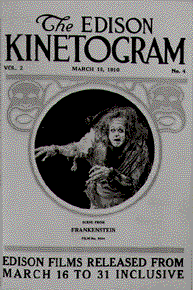 |
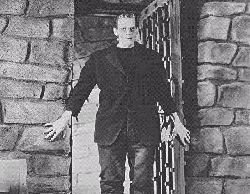 |
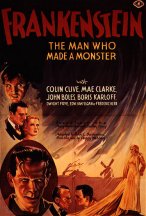 |
| The reshaping of Mary Shelley's story began almost from the moment it first appeared. The 1931 Universal Studios production of Frankenstein, starring Boris Karloff as the monster, capped more than a century of variant tellings of the original story. Compared to Shelley's sensitive, articulate creature, Universal's was crude and unformed. But the sheer power of Hollywood image-making gave him an impact as great or greater than Shelley's, and made him into an icon of popular culture. | Just
as Shelley's story was shaped by the science of the day, so was Hollywood's
influenced by some of the scientific and pseudo-scientific preoccupations
of its day, including eugenics, robots, and surgical transplants.
Frankenstein earned rave reviews, was named to top-ten lists, and made lots of money; the production cost $290,000 in Depression-era dollars, and earned more than $12 million. |
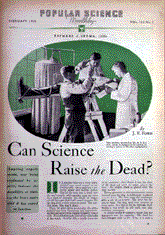 |
In
the years before Universal Studios released Frankenstein in 1931, scientists
seemed poised to penetrate once-sacrosanct boundaries between life and
death, a prospect that continued both to trouble the intellect and thrill
the imagination. Newspapers and magazines speculated freely about one day
reviving the dead, achieving immortality through the use of artificial
organs, and altering the genetic shape of future generations through eugenics.
The Universal film responded to these themes in popular culture.
Spurned
by his creator, Mary Shelley's monster kills for revenge. The movie monster,
on the other hand, kills because he's been given the brain of a criminal.
Early in the twentieth century, "biological determinism" was in the air;
heredity, more than environment or education, the idea went, caused social
problems. Proponents of eugenics wanted to improve the human species through
compulsory sterilization of criminals, the mentally retarded, and others
deemed social misfits. Some two-thirds
|
Quotations from Frankenstein
If the study to which you apply yourself has a tendency to weaken your affections, and to destroy your taste for those simple pleasures in which no alloy can possibly mix, then that study is not befitting the human mind.My dreams were all my own; I accounted for them to nobody; they were my refuge when annoyed -- my dearest pleasure when free.
Invention, it must be humbly admitted, does not consist in creating out of voice, but out of chaos.
Life is obstinate and clings closest where it is most hated.
The Modern Prometheus
The subtitle The Modern Prometheus refers to the figure in Greek mythology who was responsible for a conflict between mankind and the gods. In order to help the people, Prometheus stole Zeus's fire from the sun. The people were thereby given an advantage to the animals since fire gave man the ability to make weapons and tools. Prometheus was severely punished by Zeus who chained him to a rock in the Caucasus. Every night, Prometheus was visited by an eagle who ate from his liver. During the day, however, his liver grew back to its original state.It also refers to the story of Prometheus plasticator who was to said to have created and animated mankind out of clay.
These two myths were eventually fused together: the fire that Prometheus had stolen is the fire of life with which he animated his clay models. Because of the 'creating' aspect, Prometheus became a symbol for the creating artist in the eighteenth century.
Victor Frankenstein can indeed be seen as the modern Prometheus. He defies the gods by creating life himself. Instead of being the created, Victor takes God's place and becomes the creator. Just as Prometheus, Victor gets punished for his deeds. He is, however, punished by his creation whereas Prometheus was punished by the god who he stole from.
Encarta '95. CD-ROM. United States of America: Microsoft Corporation, 1994.
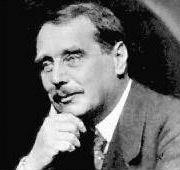 |
The
Island of Dr. Moreau(1896)
by H(erbert) G(eorge) Wells (1866-1946) "On a deceivingly beautiful island in the South Seas exists the sinister kingdom of Doctor Moreau. Shipwrecked in this seeming paradise, the unfortunate Edward Prendick stumbles upon the wild beastly creations of the sadistic doctor and enters into a bizarre and terrifying world of a doctor who plays an evil God and cruelly creates monstrosities of living creatures. The scientist playing god seems more relevant than ever in the age of cloning." |
 |
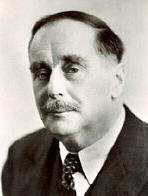
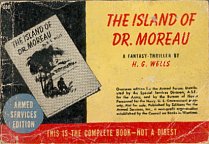
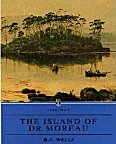


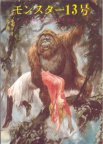
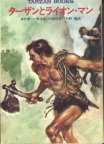
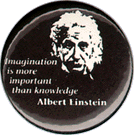
THE TARZAN CONNECTION
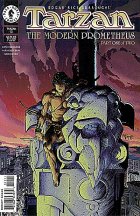 |
Issue
#13~ 97.08.06 ~ Pt. 1:
Tarzan encounters the concrete jungle! New York's scientific community is fighting over rights to the notebooks of Dr. Victor von Frankenstein, and the jungle lord finds himself pulled into the middle of the fray when a hulking monster figures into the mix. This issue features Thomas Edison, Nikola Tesla, Arthur Conan Doyle, and Frankenstein's monster! |
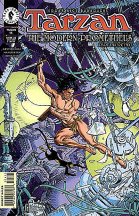 |
Issue
#14 ~ 97.09.03 ~ Pt 2:
The notes of Dr. Victor von Frankenstein, the greatest scientific mind of the nineteenth century, have fallen into the hands of the greatest scientific mind of the twentieth century, Thomas Edison. Tarzan is determined that Edison will not repeat the mistakes of the late Dr. Frankenstein . . . but there's a hulking beast that has his own stake in all of this! |
In this Wyndham classic, scientists
develop triffids: tall, three-legged ambulatory plants with poisonous whiplash
stings. As long as they are kept under control they are considered harmless...
and useful, because they can be mashed to produce a delicate pink oil,
far more nutritious and tasty than fish. However, when more scientific
meddling brings about a worldwide human disaster, the triffids who thrive
on decaying carrion, soon become a major problem to the world's survivors.
THE STEPHEN SPIELBURG CONNECTION
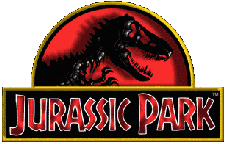 |
Jurassic Park WebRing List of Sites The Science of Jurassic Park |
 |
|
|
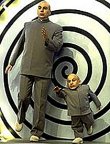 |
![]()
MONSTER
LINKS
NOTE:
These off-site links were compiled back in 2010 for our readers' reference.
Some
of them may be no longer active.
![]()
Frankenstein
e-Text v.1 v.2v.3
(annotated)
Life
of Mary Shelley
Summer
of 1816
Literary
Sources of Frankenstein
The
"Birth" of a Monster
Mary
Shelley and Frankenstein Links More
Links
Frankenstein:
Promise and Peril
Frankenstein:
The Modern Prometheus
Frankenstein
Exhibit: National Library of Medicine
Frankenstein
and Neuromancer
Genealogy
of Victor Frankenstein's relatives and friends
Frankenstein
Art Gallery
Frankenstein
references to literary works
The
Young Frankenstein Movie Transcript Script
v.2
Frankenstein
Poetry Poetry
v.2
Frankenstein
Quiz
1818
Review of the New Frankenstein Novel
The
Mortal Immortal by Mary Wollstonecraft Shelley: e-Text & Hypertext
Other
Works by Mary Shelley
Island
of Lost Souls Movie Review
The
Island of Dr. Moreau text in HTML
John
Wyndham Archive
Jurassic
Park A Reality?
Scientific
American: Your Bionic Future ~ I, Clone
Omni
Future of Cloning
Genetic
Nightmare
![]()
![]()
![]()

Volume
0398

BILL
HILLMAN
Visit our thousands
of other sites at:
BILL
and SUE-ON HILLMAN ECLECTIC STUDIO
ERB Text, ERB
Images and Tarzan® are ©Edgar Rice Burroughs, Inc.- All Rights
Reserved.
All Original
Work ©1996-2006/2009 by Bill Hillman and/or Contributing Authors/Owners
No part of this
web site may be reproduced without permission from the respective owners.